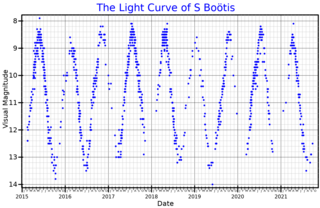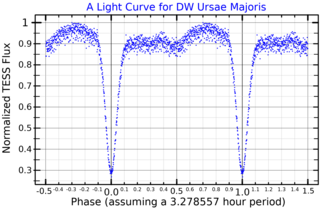Related Research Articles

The American Astronomical Society is an American society of professional astronomers and other interested individuals, headquartered in Washington, DC. The primary objective of the AAS is to promote the advancement of astronomy and closely related branches of science, while the secondary purpose includes enhancing astronomy education and providing a political voice for its members through lobbying and grassroots activities. Its current mission is to enhance and share humanity's scientific understanding of the universe as a diverse and inclusive astronomical community.

Annie Jump Cannon was an American astronomer whose cataloging work was instrumental in the development of contemporary stellar classification. With Edward C. Pickering, she is credited with the creation of the Harvard Classification Scheme, which was the first serious attempt to organize and classify stars based on their temperatures and spectral types. She was nearly deaf throughout her career after 1893, as a result of scarlet fever. She was a suffragist and a member of the National Women's Party.

Helen Battles Sawyer Hogg was an American-Canadian astronomer who pioneered research into globular clusters and variable stars. She was the first female president of several astronomical organizations and a scientist when many universities would not award scientific degrees to women. Her scientific advocacy and journalism included astronomy columns in the Toronto Star and the Journal of the Royal Astronomical Society of Canada. She was considered a "great scientist and a gracious person" over a career of sixty years.
The American Association of Variable Star Observers (AAVSO) is an international nonprofit organization. Founded in 1911, the organization focuses on coordinating, analyzing, publishing, and archiving variable star observations made largely by amateur astronomers. The AAVSO creates records that establish light curves depicting the variation in brightness of a star over time. The AAVSO makes these records available to professional astronomers, researchers, and educators.

Janet Hanula Mattei was a Turkish-American astronomer who was the director of the American Association of Variable Star Observers (AAVSO) from 1973 to 2004.

Carolyn Hurless was an American astronomer and an American Association of Variable Star Observers merit award winner. She made an estimated 78,876 astronomical observations in her lifetime.

V604 Aquilae or Nova Aquilae 1905 is a nova which was first observed in the constellation Aquila in 1905 with a maximum brightness of magnitude 7.6. It was never bright enough to be seen with the naked eye. It was discovered by Williamina Fleming on a Harvard College Observatory photographic plate taken on August 31, 1905. Examination of plates taken earlier indicates that peak brightness occurred in mid-August 1905. The star's quiescent visual band brightness is 19.6.
Arne Henden is a retired American observational astronomer, instrument and software specialist, and co-discoverer of a minor planet. He formerly served as director of the American Association of Variable Star Observers (AAVSO). The asteroid 33529 Henden is named after him.
Margaret Walton Mayall was an American astronomer. She was the director of the American Association of Variable Star Observers (AAVSO) from 1949 to 1973.
Leah Brown Allen was an American astronomer and Professor of Astronomy at Hood College.

WZ Sagittae is a cataclysmic dwarf nova star system in the constellation Sagitta. It consists of a white dwarf primary being orbited by a low mass companion. The white dwarf is about 0.85 solar masses while the companion is only 0.08 solar masses. This implies that the companion is a spectral class L2 star, although this has yet to be confirmed. The distance to this system has been determined by parallax, yielding a distance of 45.1 parsecs.

RX Andromedae is a variable star in the constellation of Andromeda. Although it is classified as a dwarf nova of the Z Camelopardalis (UGZ) type, it has shown low-luminosity periods typical of VY Sculptoris stars. However, for most of the time it varies from an apparent visual magnitude of 15.1 at minimum brightness to a magnitude of 10.2 at maximum brightness, with a period of approximately 13 days.

S Boötis is a Mira variable in the constellation Boötes. It ranges between magnitudes 7.8 and 13.8 over a period of approximately 270 days. It is too faint to be seen with the naked eye, however when it is near maximum brightness it can be seen with binoculars.
Lee Anne Willson is an American astronomer.

V455 Andromedae is a dwarf nova in the constellation Andromeda. It has a typical apparent visual magnitude of 16.5, but reached a magnitude of 8.5 during the only observed outburst.

V1315 Aquilae is a cataclysmic variable star in the north of the equatorial constellation of Aquila. It is in the sub-set of nova-like (NL) variables, specifically a SW Sextantis star. These were characterized as having non-magnetic white dwarfs – thus that do not undergo dwarf-nova bright luminations ("eruptions"). There is countering evidence for some magnetism. Being a SW Sextantis star, V1315 Aquilae has a high rate of mass transfer, so it is in steady-state accretion and in a constant state of outburst. It emits most of its light in the visible range, and this comes from the accretion disk. The eclipse depth is 1.8 mag. No description of the donor star is made.
Martha Locke Hazen was an American astronomer, best known for her contributions as curator of the Harvard astronomical photographs collection and her work on variable stars.

BZ Ursae Majoris is a dwarf nova star system in the northern circumpolar constellation of Ursa Major. It consists of a white dwarf primary in a close orbit with a red dwarf. The latter star is donating mass, which is accumulating in an accretion disk orbiting the white dwarf. The system is located at a distance of approximately 505 light years from the Sun based on parallax measurements.

DW Ursae Majoris is an eclipsing binary star system in the northern circumpolar constellation of Ursa Major, abbreviated DW UMa. It is a cataclysmic variable of the SX Sextanis type, consisting of a compact white dwarf that is accreting matter from an orbiting companion star. The brightness of this source ranges from an apparent visual magnitude of 13.6 down to magnitude 18, which is too faint to be viewed with the naked eye. The distance to this system is approximately 1,920 light years based on parallax measurements.

YY Draconis and DO Draconis are separate identifiers for what is likely the same cataclysmic variable system in the northern constellation of Draco, abbreviated YY Dra and DO Dra, respectively. The DO Dra binary star system is classified as a U Geminorum variable that ranges in luminosity from an apparent visual magnitude of 10.0 down to 15.1. It is located at a distance of approximately 639 light years from the Sun.
References
- 1 2 3 4 Oakes, Elizabeth H. "Szkody, Paula." Archived 2016-03-05 at the Wayback Machine Encyclopedia of World Scientists, Revised Edition. New York: Facts On File, Inc., 2007. American History Online. Facts On File, Inc. (accessed October 20, 2015).
- 1 2 "Paula's Astronomy Page". University of Washington Astronomy Department. Retrieved 17 October 2015.
- 1 2 "Current Board of Trustees | American Astronomical Society". aas.org. Retrieved 2023-01-03.
- 1 2 "Interview: Paula Szkody". Cataclysmic Variable Network (CVnet). 2009-03-27. Retrieved 2015-10-17.
- ↑ "Paula Szkody Appointed Editor of PASP « Astronomical Society". Astrosociety.org. Archived from the original on 2019-06-08. Retrieved 2015-10-17.
- ↑ Saladyga, Michael; Waagen, Elizabeth O. "Professional Astronomers in Service to the AAVSO" (PDF). The American Association of Variable Star Observers. Retrieved 17 October 2015.
- ↑ "Annie Jump Cannon Award in Astronomy | American Astronomical Society". Aas.org. Archived from the original on 2015-09-09. Retrieved 2015-10-17.
- ↑ Schmadel, Lutz (2015). Dictionary of Minor Planet Names Addendum to 6th Edition: 2012-2014. Springer International Publishing. p. 209. ISBN 9783319176772 . Retrieved 20 October 2015.